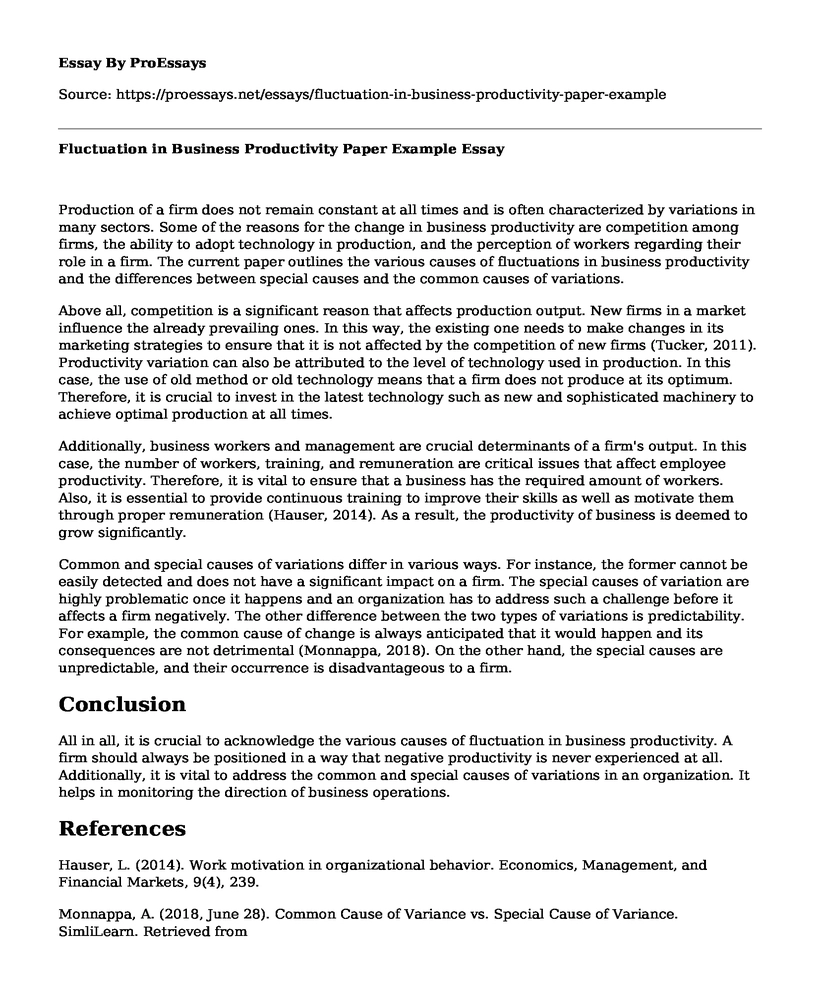Production of a firm does not remain constant at all times and is often characterized by variations in many sectors. Some of the reasons for the change in business productivity are competition among firms, the ability to adopt technology in production, and the perception of workers regarding their role in a firm. The current paper outlines the various causes of fluctuations in business productivity and the differences between special causes and the common causes of variations.
Above all, competition is a significant reason that affects production output. New firms in a market influence the already prevailing ones. In this way, the existing one needs to make changes in its marketing strategies to ensure that it is not affected by the competition of new firms (Tucker, 2011). Productivity variation can also be attributed to the level of technology used in production. In this case, the use of old method or old technology means that a firm does not produce at its optimum. Therefore, it is crucial to invest in the latest technology such as new and sophisticated machinery to achieve optimal production at all times.
Additionally, business workers and management are crucial determinants of a firm's output. In this case, the number of workers, training, and remuneration are critical issues that affect employee productivity. Therefore, it is vital to ensure that a business has the required amount of workers. Also, it is essential to provide continuous training to improve their skills as well as motivate them through proper remuneration (Hauser, 2014). As a result, the productivity of business is deemed to grow significantly.
Common and special causes of variations differ in various ways. For instance, the former cannot be easily detected and does not have a significant impact on a firm. The special causes of variation are highly problematic once it happens and an organization has to address such a challenge before it affects a firm negatively. The other difference between the two types of variations is predictability. For example, the common cause of change is always anticipated that it would happen and its consequences are not detrimental (Monnappa, 2018). On the other hand, the special causes are unpredictable, and their occurrence is disadvantageous to a firm.
Conclusion
All in all, it is crucial to acknowledge the various causes of fluctuation in business productivity. A firm should always be positioned in a way that negative productivity is never experienced at all. Additionally, it is vital to address the common and special causes of variations in an organization. It helps in monitoring the direction of business operations.
References
Hauser, L. (2014). Work motivation in organizational behavior. Economics, Management, and Financial Markets, 9(4), 239.
Monnappa, A. (2018, June 28). Common Cause of Variance vs. Special Cause of Variance. SimliLearn. Retrieved from https://www.simplilearn.com/common-vs-special-cause-of-variance-article
Tucker, I. B. (2011). Microeconomics for today. Mason, OH: SouthWestern.
Cite this page
Fluctuation in Business Productivity Paper Example. (2022, Nov 06). Retrieved from https://proessays.net/essays/fluctuation-in-business-productivity-paper-example
If you are the original author of this essay and no longer wish to have it published on the ProEssays website, please click below to request its removal:
- The Compensation of CEOs
- Essay Sample on Evaluating Performance and Training Needs
- Leadership Styles Reflection Essay
- Essay Sample on Clinical Leadership: Roles, Responsibilities and Effective Teamwork
- Essay Example on Preparing for a Leadership Role: Considerations and Questions
- Essay Example on COVID-19 Impacts: Hospitality Industry Hit Hardest by Pandemic
- Essay Example on Growth & Development: Horizontal & Vertical Integrations Strategies







